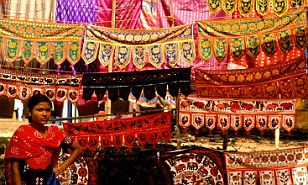Going underground: Explore Rome's crypts, catacombs and tunnels for trip back in time
- The Capuchin Crypt is home to approximately 3,700 bodies, many elaborately displayed
- The Catacombs of Domitilla is thought to be the oldest of its kind in Rome
- The Colosseum's dungeons offer a different perspective of this iconic amphitheatre
Rome’s cobbled streets are known for their architectural big-hitters – but there are also reminders of the city’s colourful past below them. From the miles of ancient catacombs dating back to the second century to the many ornate crypts that lie beneath the city’s churches, there’s plenty to discover when you explore Rome underground.

Ruins of the Colosseum’s dungeons
The Capuchin Crypt
Perhaps the most famous and fascinating underground site in Rome is the Capuchin Crypt. Located underneath the Santa Maria della Concezione dei Cappuccini on Via Veneto, it dates back to the 17th century, when a group of Capuchin monks moved into the church above and buried hundreds of friars underneath. Eerily known as the Bone Chapel, the crypt is made up of six rooms that feature some unusual (and rather grisly) décor.
Thought to now hold a staggering 3,700 bodies, the Capuchin Crypt is famous for the human bones set intricately in the walls around Christian murals and other religious artefacts. It’s an eerie place to visit and is best taken in slowly to really appreciate the level of detail and care that was put into building it. It costs €6 to enter and that includes access to the museum above, which is well worth a visit to fully understand the significance and history of the crypt.
The Catacombs of Domitilla
If you want to experience Rome’s largest underground burial site, the Catacombs of Domitilla are a must. Stretching for 11 miles below the city and built across four levels, these impressive catacombs date back to the second century. Named after the noblewoman who originally owned the land, they house the bodies of around 150,000 early Christians and Catholics.
A visit to the Catacombs of Domitilla usually takes about an hour and gives an insight into the lives of the early Christians who lived side-by-side with imperial Romans. One of the highlights is a second century fresco of the Last Supper, but there are also many other beautiful murals to see on the domed ceilings, as well as pagan symbols and intricately decorated tombs. The entrance to the catacombs is a little out of the city centre on Via delle Sette Chiese, and it’s best to pay for a tour to learn as much as you can about their detailed and rich history.
Basilica San Clemente’s underground ruins
While 12th century Basilica San Clemente is well worth a visit in itself, with its stunning mosaic and 15th century frescoes, the real highlights lie beneath the impressive church. Spreading across multiple levels, the ground-level church sits just a short walk to the east of the Colosseum, with each layer below taking you on a journey further back in time. On the lower level are the remains of an earlier fourth century basilica, but it’s after this that history takes a dramatic turn.
Just beneath lies the remains of a second century Roman house, an ancient Mithraic temple and other intriguing pagan ruins. The many layers illustrate Rome’s vibrant past and are worth the €10 entrance fee to access the areas beyond the main basilica. Truly a hidden gem, it’s not as busy as Rome’s other underground sites – but be aware that it’s not open all day, so check times before you set off.

Virgin Mary in San Clemente church
The Colosseum’s dungeons
If you don’t fancy going completely underground, a tour of the Colosseum’s dungeons will still give you an insight into the Eternal City’s morbid yet fascinating history. The dungeons set beneath the iconic landmark were the backstage area for Roman Gladiators to rest, eat and pray, as well as being the holding pen of a menagerie of exotic animals.
The dungeons were filled in during the fifth century but were recently excavated in 2010 in remarkable condition. To access the dungeons, you have to go on an organised tour. While sometimes pricey, these tours usually offer shorter entrance queues, small groups, English-speaking tour guides and access to the main structure, as well as the underground dungeons and arena floor.
Vatican grottos
If you’re short on time but still want a taster of Rome’s underground history, the grottos at the Vatican are a good option. Situated underneath St Peter’s Basilica, the series of small chapels are the resting places of many of the city’s popes and also contain ancient shrines to royals and saints (including St Peter).
Dating from medieval times to the present day, the grottos are a popular pilgrimage site and house the remains of the previous two popes. It’s free to visit but only a certain number of people are allowed in each day, and just a small portion of the tombs are open to the public. It’s best to visit in the morning to avoid queueing, and make sure you’re wearing respectable clothing to avoid being turned away at the door.
Most watched News videos
- Scottish woman has temper tantrum at Nashville airport
- Tesla Cybertruck explodes in front of Trump hotel in Las Vegas
- Mass panic as New Orleans attacker flies down Bourbon street
- Shocking moment zookeeper is fatally mauled by lions in private zoo
- Horrific video shows aftermath of New Orleans truck 'attack'
- Meghan Markle celebrates new year in first Instagram video
- Tesla Cybertruck burns outside Trump hotel in Las Vegas
- See how truck that drove into crowd made it through police barrier
- Cheerful Melania Trump bops to YMCA at Mar-a-Lago NYE bash
- New Orleans terror attack suspect reveals background in video
- Plane passenger throws drink at flight attendant in boozy fight
- Horrifying moment yacht crashes into rocks and sinks off Mexico coast













































































































